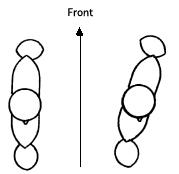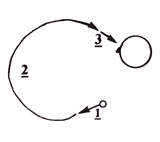Question 8. Regarding the movement of Yaegaki?
Ans. a) Take the horizontal Nukitsuke movement stepping forward with the right
foot. b
b) Do the Kiritsuke movement with the left foot forward and the right knee
on the floor. Kiritsuke movement must be at the same time.
c) Noto action must be done must be done smoothly in the same posture.
d) Next the left foot is brought to the rear to take up Han-mi (Diagonal body
posture). Sune-Kakoi (Knee protection) is done at the same time.
Addition 1) : As stated these actions should coincide with each other. Nevertheless
all too often I see the right knee touching down too late in Kirioroshi. Nakayama
Hakudo Sensei also made determinations regarding this at Toyama Nukitsuke
is the same as Mae (Sho-hatto in Shinden). At the same time as Furikaburi, the
left foot is brought forward to the right foot. Following this Kirioroshi with
the left foot stepping forward. Also at the same time, the right knee must not
touch the floor. Please consider this.
 |
2) As mentioned the Sune-Kakoi posture is called Han-Mi. According to
the explanation of Hokiyama Sensei : Because the body faces left, it finishes
in Shumoku-Ashi (Foot pointing left). However the face must be forward.
At this the body seems to facing a different angle.
The diagrams show alternative body positions. Nevertheless there is no
cause for concern on these postures, because there is no pause in the
Sune-kakoi action.
Kiritsuke action must be continued straight away. In my opinion a pretty
movement is used nowadays. Possibly because there are so many Gradings
and competitions.
|
Question 9. Regarding Tsuka-ate in Oroshi?
Answer .The purpose of the Tsuka-ate movement in Oroshi is to strike the centre
of the opponent who is leaning forward to seize your Tsuka. Addition : Strike
the centre of the opponents face with the Tsukagashira. The main motivation
of Tsuka-ate is because the opponent is Ňtrying to seize your Tsuka. Move it
downward to the left, then immediately strike the opponents face. There is a
special method of doing this;
 |
Action 1 Move the Tsukagashira downwards to the left.
Action 2 move following an upward circular movement to a position
higher than the opponents head.
Action 3 Then thrust down and forward striking the opponents face.
You will soon ascertain the logic of this movement when you conceive the
location of the opponent.
|
Question 2. Timing between techniques?
Answer In between each technique there is always Ma or distance, (see note).
Continuous movements should not carry into each other. There must be Ma at the
of each technique in preparation for the following action.
Addition :Ma in Kendo could relate to a distance between two fighters. But
in Iaido it is a type of gap which is rather difficult to explain. However the
following explanation was used by Oh-e Sensei and my teacher Yamamoto Takuji.
Grip the Tsuka firmly (with one or both hands) at the
end of each action before starting the next movement is to study under
a competent teacher/instructor to perfect the matter of Ma.
(Editors Note) To those that are new to sword arts, Ma is perhaps better translated
as an interval. An interruptive period or space between two opponents.
 |
Sections 2 and 3 |

